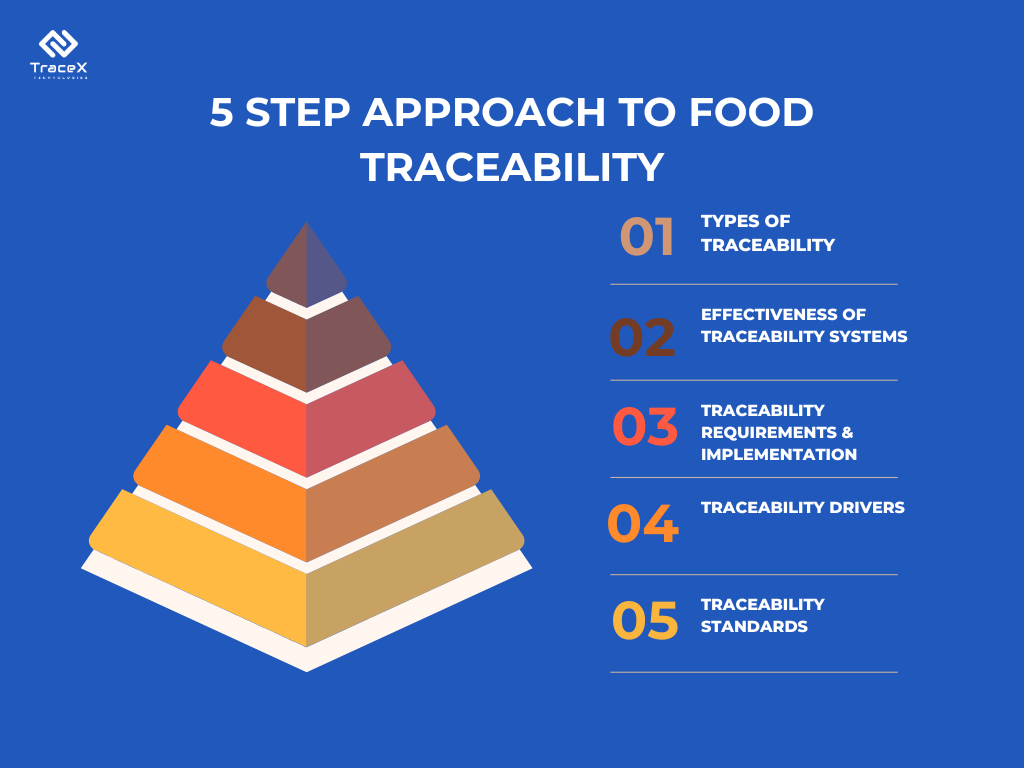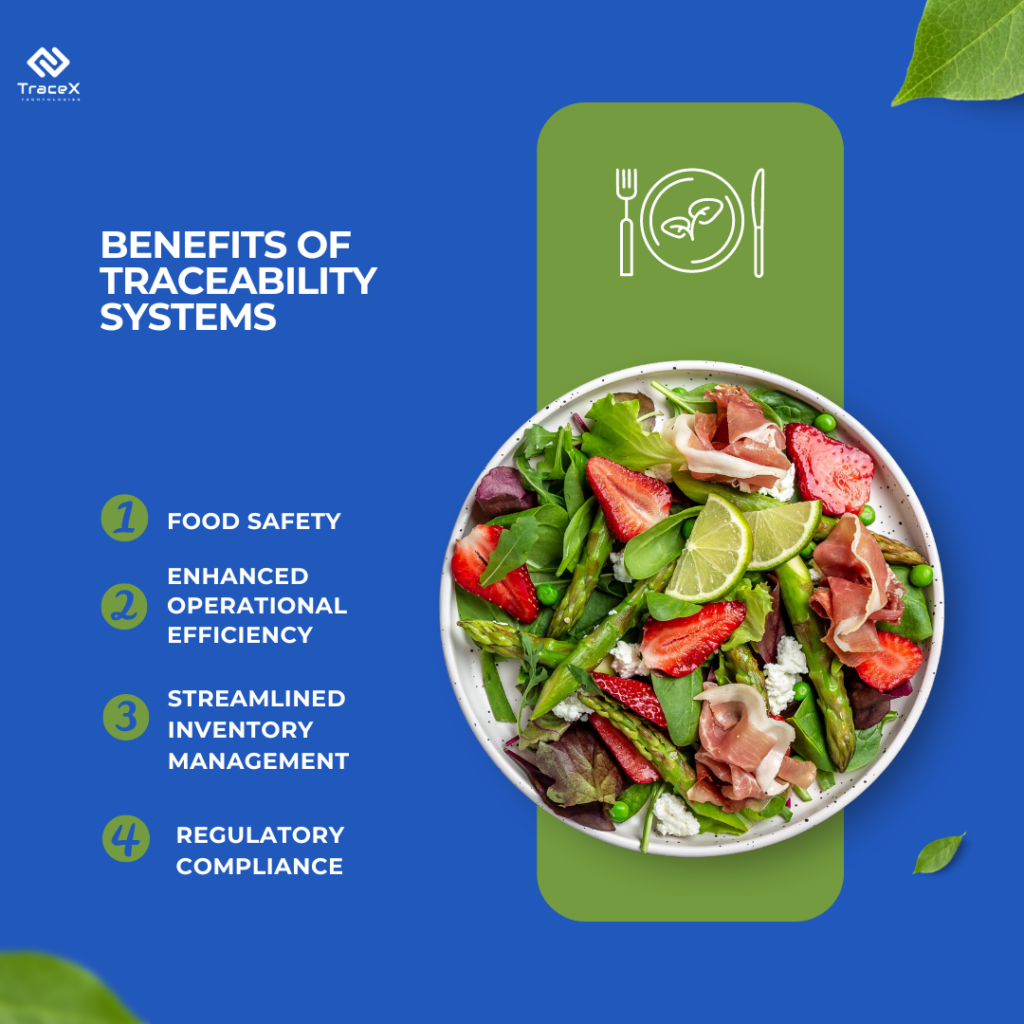Contact: +91 99725 24322 |
Menu
Menu
Quick summary: Enhance food safety and transparency with a comprehensive 5-step approach to food traceability. Learn how robust traceability systems ensure product integrity from farm to fork, promoting consumer trust and regulatory compliance.

The various scandals rocking the food industry over years has disrupted the food ecosystem and shattered the confidence of end consumers. Food Recalls and Food Safety has become a major concern in the Food industry. Governments, companies and the end consumers want to know how the foods they purchase were prepared and where it came from. The food industry has to bring in this transparency in order to thrive in this market. Food Traceability is an important component of a business’s overarching Food Safety program.
“The ability to follow the movement of food products and their ingredients throughout the supply chain both upward and downward is known as traceability”. It is a system that links the production, processing, and distribution and makes it possible to locate a product at any given stage in the supply chain.
Today both the consumer and the producer want their product to be of the highest quality.
A consumer has every right to know about the origin of the product, common allergens used in the process, and the organic raw materials sourced.
Meanwhile, the producers want to build trust among the customers by providing quality and valid data certificates about the product.
According to the World Health Organization an estimated 600 million – almost 1 in 10 people in the world – fall ill after eating contaminated food and 420 000 die every year. In the Global market, food safety and management issues have to align with the food safety systems, internal and external to the supply chain.
The proper sourcing of raw materials along with strict processing norms and proper documentation will help in adhering to safety concerns. To achieve such safety, systematic management, track, and trace solutions are vital. Food traceability helps in product recalls and timely withdrawals of products in the food chain.
Food contamination refers to the presence of harmful substances or microorganisms in food that can cause illness or injury when consumed. These contaminants can include bacteria, viruses, parasites, chemicals, toxins, or foreign objects like glass or metal fragments. Contamination can occur at various stages of the food production and supply chain, including farming, processing, packaging, transportation, storage, and preparation.
Traceability systems play a crucial role in addressing the problem of food contamination by enabling the tracking and tracing of food products throughout the supply chain. These systems utilize technologies such as barcodes, RFID tags, and blockchain to record and store information about the origin, processing, handling, and distribution of food items.
By implementing traceability systems, food producers, manufacturers, distributors, and retailers can:
Identify the Source of Contamination: Traceability systems allow for the rapid identification of the source of contamination in the event of a food safety issue or outbreak. By tracing back through the supply chain, stakeholders can pinpoint where the contamination occurred and take corrective action to prevent further distribution of affected products.
Facilitate Targeted Recalls: In the event of a food safety recall, traceability systems enable targeted recalls of specific batches or lots of contaminated products. This reduces the scope and impact of recalls, minimizing the risk to consumers and mitigating financial losses for businesses.
Ensure Accountability and Transparency: Traceability systems promote accountability and transparency in the food supply chain by providing visibility into each step of the production and distribution process. This encourages adherence to food safety standards and regulations and fosters trust among consumers.
Enhance Food Safety Management: By capturing data on factors such as temperature, humidity, processing methods, and transportation conditions, traceability systems support effective food safety management practices. This data can be used to identify potential risks, monitor compliance with safety protocols, and implement preventive measures to reduce the likelihood of contamination.
Overall, traceability systems are essential tools for mitigating the risks associated with food contamination, safeguarding public health, and ensuring the integrity and safety of the food supply chain.
Tracking and Tracing in the food supply chain is important to ensure food safety and compliance with regulations. This involves:
Tracking and Tracing enhance the efficiency of a food supply chain, guaranteeing a safe and a quality product to the consumer and at the same time adhering to the necessary standards and regulations. Check out the best practices that can be adopted in food traceability.

This type of traceability allows you to track a product from its origin at the farm all the way to its final destination, the supermarket shelf. This means that the product can be traced forward in time and space from the point of production to point of consumption and ensure that the product is safe and meets the regulatory requirements throughout its journey in the food supply chain.
This type of traceability allows you to track a product from the retail shelf back to its origin, the farm. This means that the product can be traced backward in time and space from the final destination to the source of origin. This helps to identify the source of problems that could arise due to food contamination and disease outbreaks, thereby aiding in food recalls.
This type of traceability allows you to track a product within a specific facility or location, such as a processing plant or warehouse. This is important for ensuring that products are handled and processed correctly and for identifying any issues.
This type of traceability allows you to track a product as it moves between different facilities or locations in the supply chain. This is important for ensuring that products are properly handled and transported throughout the supply chain and for identifying any issues that may arise during transportation.
Each type of traceability is important to ensure the safety and quality of the product. The end-to-end traceability brings visibility and transparency in the food supply chain, winning consumer’s trust in the food they eat.
The effectiveness of a traceability system is crucial to ensure they are working efficiently and effectively.
Measuring the effectiveness of a traceability system is a must to ensure that the systems are functioning to deliver the benefits cited.
Mapping traceability requirements and implementation is an important step towards ensuring an effective traceability system. Identifying and documenting the various stages in the supply chain and tracking and recording data at each stage is vital. Some of the key steps are:
Mapping traceability requirements helps to have a comprehensive traceability system in place which can enable track and trace of products in the supply chain. This improves food safety and satisfies regulatory requirements.
Consumers are demanding greater transparency and accountability from companies around food safety, sustainability and ethical practices. Traceability enables transparency and visibility across the supply chain , thereby building consumer trust.
Traceability helps companies to identify risks associated with issues related to food contamination and disease outbreaks. This helps to mitigate reputational and financial risks associated with product recalls or supply chain disruptions.
Traceability can help companies to demonstrate their commitment to sustainability and providing visibility into the environmental and social impact of their products. This provides a competitive edge to the companies who assure a trustworthy brand.
Traceability helps companies to optimize their supply chain operations by providing real-time capability of data capture all along the supply chain. This improves efficiency, reduces waste and minimizes costs.
Traceability enables companies to be compliant with the regulatory standards by providing a transparent and auditable record of the product’s journey through the supply chain.
These drivers demonstrate the importance of traceability as a must have for companies to meet consumer demands and satisfy the regulatory markets.
Private standards for traceability can help companies ensure that their products are responsibly sourced, meet the expectations of consumers and the stakeholders and comply to the relevant regulations and standards.
Private standards for traceability are developed by industry groups or private organizations to meet specific requirement related to traceability of materials or products.

Farm management software plays a pivotal role in promoting traceability within agricultural value chains by providing comprehensive tools to track and manage farm activities from seed to harvest. Through digital platforms, farmers can record crucial data such as crop planting dates, inputs used, irrigation schedules, and pest management strategies. This real-time information enables stakeholders throughout the value chain to trace the journey of agricultural products back to their source, ensuring transparency and accountability. Additionally, farm management software facilitates compliance with quality standards and certifications, enhances efficiency in farm operations, and improves decision-making processes. Ultimately, by integrating traceability into farm management practices, software solutions contribute to building trust among consumers, strengthening food safety measures, and fostering sustainable agricultural practices.
TraceX’s Farm Management Solutions drive traceability and sustainability in food supply chains by providing comprehensive tools to digitize and optimize farm operations. Through these solutions, farmers can track every aspect of their production process, from seed selection to harvest, recording key data such as planting dates, inputs used, and cultivation practices. This data is then securely stored on a blockchain-enabled platform, ensuring transparency and traceability throughout the entire supply chain.
By leveraging TraceX’s Farm Management Solutions, stakeholders across the food supply chain, including producers, distributors, and consumers, can access real-time information about the origin and journey of agricultural products. This transparency enables better decision-making, enhances food safety measures, and builds trust among consumers.
Furthermore, TraceX’s Farm Management Solutions support sustainability initiatives by promoting best practices in agriculture, such as regenerative farming techniques, soil health management, and water conservation. By optimizing resource utilization and minimizing environmental impact, these solutions contribute to building a more sustainable and resilient food system.
In conclusion, adopting a comprehensive 5-step approach to food traceability is essential for ensuring the safety, quality, and integrity of food products throughout the supply chain. By implementing robust traceability systems, businesses can effectively track and monitor the movement of food items from farm to fork, enabling quick identification and response to any issues or recalls. This not only enhances consumer confidence but also helps companies comply with regulatory requirements and industry standards. Additionally, leveraging technology solutions like blockchain and RFID can further enhance the efficiency and accuracy of food traceability efforts. Overall, prioritizing food traceability is crucial for building trust, mitigating risks, and ultimately safeguarding public health in the food industry.
